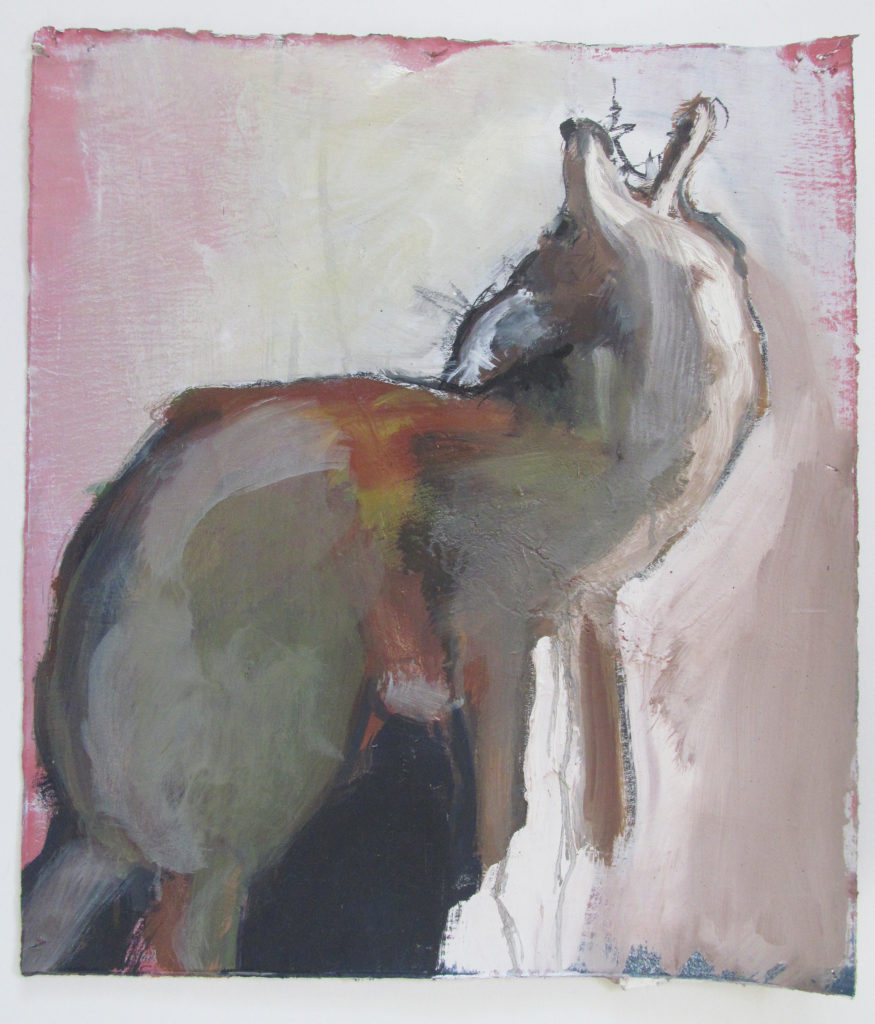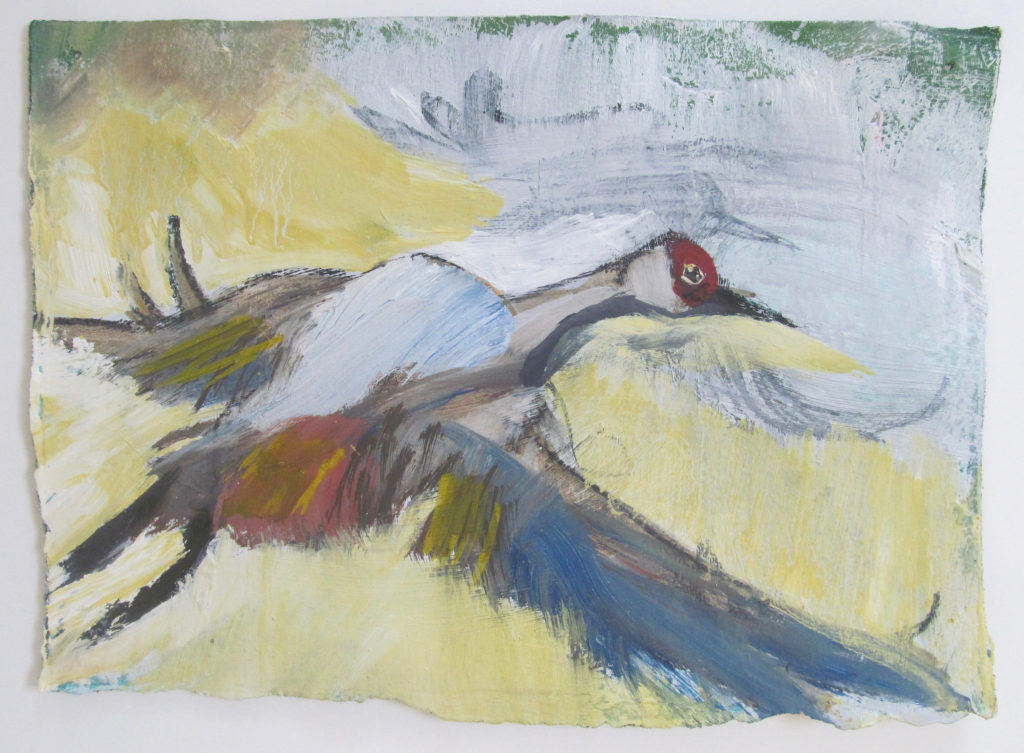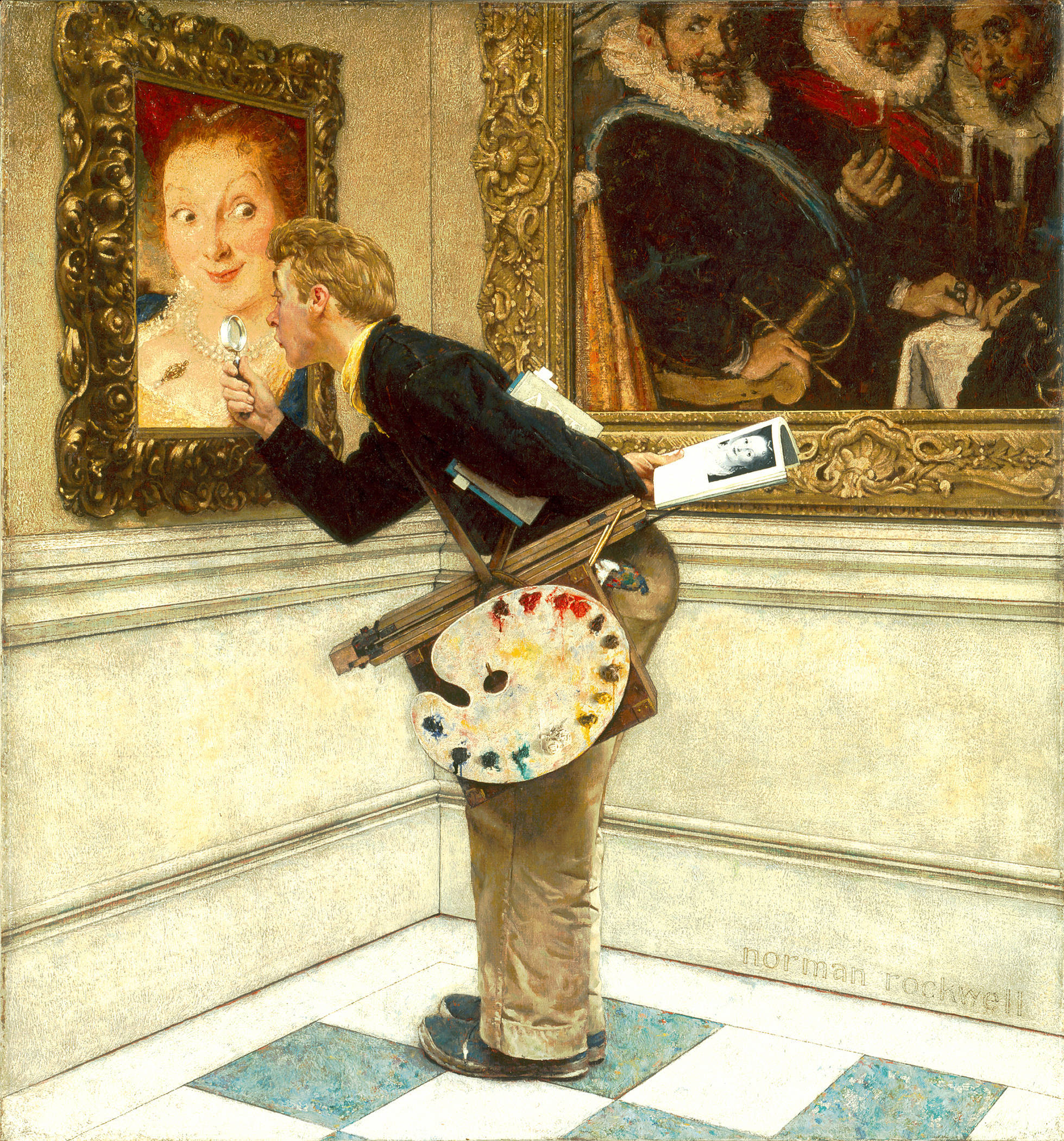Daniel Pfalzgraf, Attica Scott, and Mahogany Mayfield in front of “Glory” by CreativeSoul Photography.
Interview by Keith Waits
Entire contents are copyright © 2020 by Keith Waits. All rights reserved.
Daniel Pfalzgraf is a multimedia artist and curator who has been exhibiting art professionally for twenty years. He is currently the Curator for the Carnegie Center for Art & History in New Albany, Indiana. Pfalzgraf was also previously Director of The Green Building Gallery, Director of Media Services at B. Deemer Gallery, and an assistant preparator at the Speed Art Museum (all in Louisville, Kentucky) and was the Media Coordinator at Bill Lowe Gallery in Atlanta, Georgia. He has also worked as an independent curator creating exhibitions under the name of LoCAL.gallery.
Pfalzgraf’s current series of work, Kentucky Game, are blind contour drawings on paper painted in with oil paint and other mixed media and explore the themes of attraction, hunting, and collecting. Pfalzgraf has blockchain-based digital artwork based on this series available to buy and sell on the Pixura platform and also maintains a blockchain-based digital art collection on the SuperRare platform. Artwork included are pieces created by other artists and are available for sale.
1. How has The Carnegie Center created programming to engage its audience?
All hands on deck. We are all chipping in to create content in as many forms for as many different audiences as we can.
Al Gorman is a great writer and he’s been working on a series of blog posts about some prominent local artists, such as a Barney Bright (including a walking tour of his work in New Albany). He’s also developed different art activities that can be done with common materials found in many households.
Julie Leidner has been developing some art activities for elementary and middle school students.
Eileen Yanoviak is hosting preschool art playdates online, and book club discussions for adults.
Since the museum is closed and people can’t come to see the current exhibition, Permanent and Natural, I’ve been working on trying to create ways for people to experience the work online, such as getting all the images and label copy online. I’ve also been writing an online interactive “Choose Your Own Adventure” story based on artwork in the exhibition that will be a fun way for kids to explore the work in the show.
Just before everything got put on lockdown, I interviewed State Rep. Attica Scott and Mahogany Mayfield, a founder of Girls League of the West (GLOW). We recorded it and will be posting it next week. I have to give a big shout out to our media coordinator, Jesse Fox. She’s been doing a ton of work managing our social media scheduling, editing videos, and managing our website and digital content.
We are also developing ways that we can engage with high school students, with seniors who are quarantined in assisted living facilities, as well as some potentially fun public art initiatives. Those projects haven’t been released yet, but will be added to our newly created Digital Resources page on our website as we continue to create new content to share. Sometimes, we also just have to add a little levity to the situation and hop on the social media trends of the day, like the Carnegie Center Quarantine House Challenge, where people pick which art exhibitions they’d want to be quarantined with.
One of the most challenging things is trying to serve those who don’t have access to online content. Eventually, we will be able to go back to working in the museum and the library (the Carnegie Center is a branch of the Floyd County Public Library) on a limited basis prior to opening up to the public. Once we get to that point, we can grow our reach by creating projects that can be distributed through the Library-To-Go program. There’s no telling how long this will last, obviously, but we’re creative people and there are a lot of ways we can work with limited resources and exposure.
2. At the moment, how far out have you canceled or postponed things?
It’s a bit of a moving target, and we’ve had to adapt from one day to the next based on the news. Many of our programs are canceled/postponed “until further notice.” That will likely be in place until at least the fall, if not longer. Some exhibitions have been postponed.
We hope we will be able to provide limited access to our space later this summer, but who knows.
3. Do you anticipate being able to reschedule?
Many of them, yes. We had one major program planned that we had to cancel.
I’ve been fortunate to be able to maintain flexibility with our exhibitions, so (fingers crossed), no one will need to miss out on any shows on our schedule.
The artists in Permanent and Natural have agreed to let us hold on to their work so we can extend it until the end of July. The show was only open for a few weeks before we had to close everything down, and it has some really amazing work in it, so I hope there will be some time for people to come see it.
Form, Not Function, our annual art quilt exhibition that is one of our most popular shows that typically opens in May, but I was able to push it to August – October, and reopen the call for art for it.
Past Performance As Indicator of Future Outcomes, a group show of women who use artificial intelligence to create art has been moved from this year to next (Feb – April, 2021). I think it’s going to be pretty groundbreaking for our community, the first of its kind that I’m aware of in the region. So we decided to move it back to protect it, so to speak. In order to serve the artists and community best, we want to exhibit it when we can get maximum engagement.
The most difficult part, I feel, doesn’t necessarily have anything to do with being able to physically serve our community. The challenge is going to be how we will be able to create these programs and exhibitions with major drops in funding being projected. Many foundations and donors are reallocating their funding from cultural institutions to services that address disruptions caused by the COVID-19 pandemic. An understandable, but still unfortunate position to find ourselves in. But, you do what you can do and keep pressing forward with what you have to the best of your abilities. Being an institution that provides free programs and exhibitions, we really have to step up and provide great opportunities for the community, especially in times where people are under considerable strain.
4. Your education is as an artist and you have exhibited quite a bit. What pulled you in the curatorial direction?
Well, my love has always been about art, whether mine or others. I love making it and I love looking at it. It’s kind of been a personal mission for me to grow understanding and appreciation of contemporary art with more and more people. I love it, and I want others to love it like I do, or at the very least develop an appreciation of the benefits it provides. I started that mission by being an artist and creating installations and exhibitions that I thought would excite, educate, and entertain people. I’ve had some very powerful moments talking with strangers about the work and themes behind my work at Swanson Contemporary. I think I really helped develop some deep connections with people who weren’t frequent or typical “art people.”
Curation, for me, began developing while I was living in Atlanta and grew after moving back to Louisville working in galleries and museums. Working in the art world every day, you really get to see how much great work is being made by so many artists out there. They’re able to say and create so many different things, and they can do it better than I ever could as an individual artist. So, I just felt like I could serve the community, and my mission, better by featuring other’s work more than my own work. That allows me to explore more and different topics than I could address with my work, and I could do it with much more frequency.
I basically curate three or four shows a year now, all with their own unique focus. That can reach so many more people than if I focused on creating one body of work for solo shows every two years.
5. You had built a reputation as an independent curator. What has it been like fulfilling that role for an established institution like The Carnegie?
Beyond the stability and consistency of work, the biggest difference (and benefit) is 1.) having an institutional name behind you to gain access to artists’ work, and 2.) having an actual budget to work with. I HIGHLY recommend being able to work with a budget. (LOL) Not that I have a huge budget to work with, it’s actually quite modest, to be honest. For comparison’s sake, the Carnegie’s exhibition budget is only approximately 3.5% of the Speed Art Museum’s exhibitions budget. But I can get creative and stretch the impact of each dollar spent on the exhibitions. I never would ever have been able to show work by Kerry James Marshall, Dread Scott, Fahamu Pecou, Sonya Clark, William Wegman, or Robert Pruitt if I was independently curating local spaces. Sorry about that name dropping, but I am quite proud of what I have been able to accomplish at the Carnegie.
Working independently offers exciting energy developing unique shows with ever-changing sets of constraints (resources and spaces, primarily). Sometimes you may have a little more freedom (like with content), but the opportunities to do things are fewer and further apart.
I still get that thrill of wide-open opportunities when working on our public art program, though. Changing spaces and budgets keeps things exciting. We are finishing up the region’s first public art skatepark, the New Albany Flow Park. That was a major project that took over four years to complete, but we did it. The idea was something that I may have thought of before working at the Carnegie, but having that institutional name and reputation behind me helped legitimize the project and provided access I couldn’t have had otherwise. Shout out to Mayor Jeff Gahan and the City of New Albany, SoIN (the Southern Indiana Convention and Tourism Bureau), Develop New Albany, the Humana Foundation, the Community Foundation of Southern Indiana, Duke Energy, Ceasar’s Foundation of Floyd County, Samtec Cares, and all the individuals who contributed to making the dream a reality.
6. What do you imagine “The New Normal” will look like for visual arts?
A lot less money to work with for starters. I imagine that will be a temporary condition, but it will be interesting to see who is able to do what with less in the foreseeable future.
Last year, I was on a panel at the Louisville Free Public Library called “Conversations with a Curator.” The moderator, Chelsea Harris, asked the panel what we saw in the future for contemporary art and curators. My answer then was I predicted we would see a radical shift of decentralization of the current art world structure. Fewer ivory towers and king-makers. More influencers. I also said that today’s curators will be working in marketing and sales tomorrow.
I know that probably sounded pretty hyperbolic at the time, but if anything, the current climate of our situation only strengthens my belief in that. Everyone is rushing to develop new and unique content to draw eyes on their projects, they’re becoming marketers and influencers whether they want to or not (some better than others). I don’t think all that work will be forgotten about and discontinued once we are able to gather in groups publicly again.
The part regarding the decentralization of the art market relates to another thing that I am very much interested in, digital-based artwork. Self-quarantining and online transactions will only expand the reach and impact of digital art in the art world.
This is something that I am pretty passionate about, and I also think that it is something that our region is woefully behind in. Crypto Art (art saved on blockchain), finally provides an avenue that allows artists to create digital artwork and provide verified one-of-a-kind uniqueness as a digital asset so people can freely buy and sell digital-based work without diminishing value due to duplicity.
I want to bring awareness to these things to our community, which is one of the reasons we’re doing the Past Performance… Artificial Intelligence-based exhibition. But there is only so much I can do in my role as a curator. We need investment from our leaders and institutions if we want to be relevant beyond our fifty-mile radius.

COY howl, Charcoal and oil on paper, 22 1/2 x 19 1/2 inches, Daniel Pfalzgraf
7. Do your responsibilities in New Albany allow you sufficient time for a studio practice?
I do have a body of work in progress, but I am slower to produce than I used to be. Part of that, too, is because I don’t have any immediate plans for showing it. I started showing at Swanson Contemporary in 2004, but now that they’re closed, I doubt I’ll try showing with any other local galleries.
I have a series of paintings I’ve been working on with around 30 or 40 something pieces completed, but I hope to have twice that many done eventually.
8. What do you feel is most needed in the Louisville area’s visual arts community?
Digital art…artists, buyers, sellers, and exhibitions. Innovators and investors.
Also, better representation that extends beyond the city so it’s easier for artists to live here and make a living. I have a whole list of things I think we need here that I would love to make happen, but I can’t give everything away free (lol).
9. If you hadn’t become an artist, what would you be doing?
Marketing. I think it’s really fun trying to figure out how to get people to pay attention to what you want and getting them to invest in it. A few years back I went back to school to get an MBA degree, and the marketing classes were by far my favorite courses, by a wide margin.
I’d like to think I’d be a plastic surgeon, but I don’t think I could’ve gotten into med school with my grades in high school.
10. What music have you been listening to?
I have a shuffle mix of music that I play all the time: Destiny’s Child, Electric Wizard, The Misfits, Mastodon, The Birthday Party, MGMT, Frank Ocean, fIREHOSE, Kendrick Lamar, Burning Spear, Led Zeppelin, Black Sabbath, The Stooges, Noname, Oddisee, Childish Gambino, Black Uhuru, The Cars, Black Moth Super Rainbow, Bauhaus, Jay-Z, Kid Cudi, Johnny Cash, Digable Planets, Bjork, Fugazi, Animal Collective, The Black Angels, The Police, A Tribe Called Quest, Outcast, Quasimoto, Joy Division, Modeselektor, Melvins, Rung Petchburi, and The Sugarcubes.
A few other performers pop in and out of that shuffle from time to time, but those are the basic foundation.
11. What book is on your bedside table now?
A stack of completed, in progress, and likely abandoned books.
Completed:
The Pentagon’s Brain: An Uncensored History of DARPA, America’s Top-Secret Military Research Agency, by Annie Jacobsen (really interesting read)
The Escape Artist, by Brad Meltzer (pretty terrible read)
In progress:
Predictably Irrational, by Dan Ariely (enjoying it so far)
Likely abandoned (maybe pick back up another day):
Game of Thrones, by George R. R. Martin (meh)
Saint Germain on Alchemy (I’ve started and stopped this one the past 15 years)
12. What is the first thing you will do when you can come out of quarantine?
Probably go get some ice cream with my daughter, and go to the skatepark with my son. And if Louisville City FC is playing, going to games at the new stadium.

SHC small, Charcoal and oil on paper, 8 1/2 x 11 1/2 inches, Daniel Pfalzgraf
Keith Waits is a native of Louisville who works at Louisville Visual Art during the days, including being the host of LVA’s Artebella On The Radio on WXOX 97.1 FM / ARTxFM.com, but spends most of his evenings indulging his taste for theatre, music and visual arts. His work has appeared in LEO Weekly, Pure Uncut Candy, TheatreLouisville, and Louisville Mojo. He is now Managing Editor for Arts-Louisville.com.




